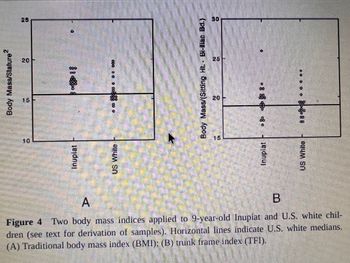
MATLAB: An Introduction with Applications
6th Edition
ISBN: 9781119256830
Author: Amos Gilat
Publisher: John Wiley & Sons Inc
expand_more
expand_more
format_list_bulleted
Question
I need an answer based on figure 4A and 4B
The body mass index calculation for figure 4A shows the Inuit children to ___________, while the calculation for 4B shows the Inuit children to _____.
|
weigh less than US whites; be equal to US whites |
||
|
be equal to US whites; weigh more than US whites |
||
|
weigh less than US whites; weigh more than US whites |
||
|
weigh more than US whites; be equal to US whites
|

Transcribed Image Text:### Figure 4: Comparative Analysis of Body Mass Indices
This figure illustrates two body mass indices applied to 9-year-old Inupiat and U.S. white children. The horizontal lines in both graphs represent the medians for U.S. white children.
#### Graph A: Traditional Body Mass Index (BMI)
- **Y-axis:** Body Mass/Stature²
- **X-axis Categories:** Inupiat, U.S. White
- **Data Representation:** Scatter plots with individual data points for each group.
- **Observations:** The Inupiat children generally have higher BMI values compared to U.S. white children. The median line indicates that the median BMI for U.S. white children is lower than the BMI of most Inupiat children.
#### Graph B: Trunk Frame Index (TFI)
- **Y-axis:** Body Mass/(Sitting Height - BiIiac Breadth)
- **X-axis Categories:** Inupiat, U.S. White
- **Data Representation:** Scatter plots with individual data points for each group.
- **Observations:** Similar to graph A, the Inupiat children tend to have higher TFI values than U.S. white children. The median line for U.S. white children is lower than most of the TFI values for Inupiat children.
The data indicates variations in body mass distribution between the two groups, which may reflect genetic, environmental, or cultural influences. Further analysis can help to understand the underlying causes of these differences.
(Note: See accompanying text for more details on sample derivation and methodology.)
Expert Solution
This question has been solved!
Explore an expertly crafted, step-by-step solution for a thorough understanding of key concepts.
This is a popular solution
Trending nowThis is a popular solution!
Step by stepSolved in 2 steps

Knowledge Booster
Similar questions
- e range. -36 39 46 43 37 34 56 43 34 15 52 38 49 29 29 is 22, is iS mals.)arrow_forwardSolve the attached question and give final answers please.The question and historical data is attached.arrow_forwardMan.3 The ratio of boys to girls at Wells College is currently 3 to 7 . If there are 525 girls, how many boys are enrolled this year?arrow_forward
- Please solve the attached question parts a,b, and carrow_forwardOption 1: 1/2 Option 2: 2 Option 3: 4 Option 4: 8 Option 5: 16arrow_forward17 Mrs. Joplin is the teacher sponsor for her school's book club. She recorded the number of books each book club member read over the summer in the dot plot below. (Note: Each dot represents one student.) Book Club Members 1 2 3 4 5 6 7 8 9 10 Number of Books Read What is the ratio of the number of students who read four books to the number of students who read eight books? OA. 2 to 5 В. 5 to 2 С. 1 to 2 D. 2 to 1arrow_forward
arrow_back_ios
arrow_forward_ios
Recommended textbooks for you
 MATLAB: An Introduction with ApplicationsStatisticsISBN:9781119256830Author:Amos GilatPublisher:John Wiley & Sons Inc
MATLAB: An Introduction with ApplicationsStatisticsISBN:9781119256830Author:Amos GilatPublisher:John Wiley & Sons Inc Probability and Statistics for Engineering and th...StatisticsISBN:9781305251809Author:Jay L. DevorePublisher:Cengage Learning
Probability and Statistics for Engineering and th...StatisticsISBN:9781305251809Author:Jay L. DevorePublisher:Cengage Learning Statistics for The Behavioral Sciences (MindTap C...StatisticsISBN:9781305504912Author:Frederick J Gravetter, Larry B. WallnauPublisher:Cengage Learning
Statistics for The Behavioral Sciences (MindTap C...StatisticsISBN:9781305504912Author:Frederick J Gravetter, Larry B. WallnauPublisher:Cengage Learning Elementary Statistics: Picturing the World (7th E...StatisticsISBN:9780134683416Author:Ron Larson, Betsy FarberPublisher:PEARSON
Elementary Statistics: Picturing the World (7th E...StatisticsISBN:9780134683416Author:Ron Larson, Betsy FarberPublisher:PEARSON The Basic Practice of StatisticsStatisticsISBN:9781319042578Author:David S. Moore, William I. Notz, Michael A. FlignerPublisher:W. H. Freeman
The Basic Practice of StatisticsStatisticsISBN:9781319042578Author:David S. Moore, William I. Notz, Michael A. FlignerPublisher:W. H. Freeman Introduction to the Practice of StatisticsStatisticsISBN:9781319013387Author:David S. Moore, George P. McCabe, Bruce A. CraigPublisher:W. H. Freeman
Introduction to the Practice of StatisticsStatisticsISBN:9781319013387Author:David S. Moore, George P. McCabe, Bruce A. CraigPublisher:W. H. Freeman

MATLAB: An Introduction with Applications
Statistics
ISBN:9781119256830
Author:Amos Gilat
Publisher:John Wiley & Sons Inc

Probability and Statistics for Engineering and th...
Statistics
ISBN:9781305251809
Author:Jay L. Devore
Publisher:Cengage Learning

Statistics for The Behavioral Sciences (MindTap C...
Statistics
ISBN:9781305504912
Author:Frederick J Gravetter, Larry B. Wallnau
Publisher:Cengage Learning

Elementary Statistics: Picturing the World (7th E...
Statistics
ISBN:9780134683416
Author:Ron Larson, Betsy Farber
Publisher:PEARSON

The Basic Practice of Statistics
Statistics
ISBN:9781319042578
Author:David S. Moore, William I. Notz, Michael A. Fligner
Publisher:W. H. Freeman

Introduction to the Practice of Statistics
Statistics
ISBN:9781319013387
Author:David S. Moore, George P. McCabe, Bruce A. Craig
Publisher:W. H. Freeman